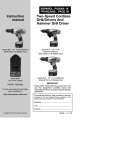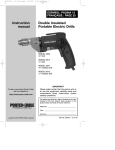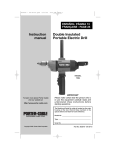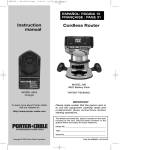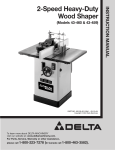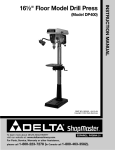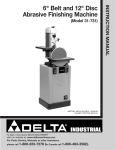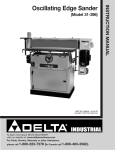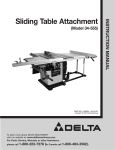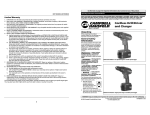Download Delta CL180JS Instruction manual
Transcript
(Model CL180) Charger Model CL180C Battery Model CL180B PART NO. 906994 - 07-15-03 Copyright © 2002 Delta Machinery ESPAÑOL: PÁGINA 14 To learn more about DELTA MACHINERY visit our website at: www.deltamachinery.com. For Parts, Service, Warranty or other Assistance, please call 1-800-223-7278 (In Canada call 1-800-463-3582). INSTRUCTION MANUAL Cordless Drill/Driver and Charger SAFETY GUIDELINES / DEFINITIONS This manual contains information that is important for you to know and understand. This information relates to protecting YOUR SAFETY and PREVENTING EQUIPMENT PROBLEMS. To help you recognize this information, we use the symbols listed below. Please read the manual and pay attention to these sections. indicates an imminently hazardous situation which, if not avoided, will result in death or serious injury. indicates a potentially hazardous situation which, if not avoided, could result in death or serious injury. indicates a potentially hazardous situation which, if not avoided, may result in minor or moderate injury used without the safety alert symbol indicates potentially hazardous situation which, if not avoided, may result in property damage. SOME DUST CREATED BY POWER SANDING, SAWING, GRINDING, DRILLING, AND OTHER CONSTRUCTION ACTIVITIES contains chemicals known to cause cancer, birth defects or other reproductive harm. Some examples of these chemicals are: · lead from lead-based paints, · crystalline silica from bricks and cement and other masonry products, and · arsenic and chromium from chemically-treated lumber. Your risk from these exposures varies, depending on how often you do this type of work. To reduce your exposure to these chemicals: work in a well ventilated area, and work with approved safety equipment, such as those dust masks that are specially designed to filter out microscopic particles. Read Operator’s Manual. Do not operate equipment until you have read Operator’s Manual for Safety, Assembly, Operation, and Maintenance Instructions. GENERAL SAFETY RULES FOR ALL BATTERY OPERATED TOOLS READ AND UNDERSTAND ALL INSTRUCTIONS. Failure to follow all instructions listed below, may result in electric shock, fire and/or serious personal injury. SAVE THESE INSTRUCTIONS. WORK AREA 1. Keep your work area clean and well lit. Cluttered benches and dark areas invite accidents. 2. Do not operate power tools in explosive atmospheres, such as in the presence of flammable liquids, gases, or dust. Power tools create sparks which may ignite the dust or fumes. 3. Keep bystanders, children, and visitors away while operating a power tool. Distractions can cause you to lose control. ELECTRICAL SAFETY 1. Do not abuse the cord. Never use the cord to carry the tool. Keep cord away from heat, oil, sharp edges or moving parts. Replace damaged cords immediately. Damaged cords may create a fire. 2. A battery operated tool with integral batteries or a separate battery pack must be recharged only with the specified charger for the battery. A charger that may be suitable for one type of battery may create a risk of fire when used with another battery. 2 3. Use battery operated tool only with specifically designated battery pack. Use of any other batteries may create a risk of fire. PERSONAL SAFETY 1. Stay alert, watch what you are doing, and use common sense when operating a power tool. Do not use tool while tired or under the influence of drugs, alcohol, or medication. A moment of inattention while operating power tools may result in serious personal injury. 2. Dress properly. Do not wear loose clothing or jewelry. Contain long hair. Keep your hair, clothing, and gloves away from moving parts. Loose clothes, jewelry, or long hair can be caught in moving parts. 3. Avoid accidental starting. Be sure switch is in the locked or off position before inserting battery pack. Carrying tools with your finger on the switch or inserting the battery pack into a tool with the switch on invites accidents. 4. Remove adjusting keys or wrenches before turning the tool on. A wrench or a key that is left attached to a rotating part of the tool may result in personal injury. 5. Do not overreach. Keep proper footing and balance at all times. Proper footing and balance enables better control of the tool in unexpected situations. 6. Use safety equipment. Always wear eye protection. Dust mask, nonskid safety shoes, hard hat, or hearing protection must be used for appropriate conditions. TOOL USE AND CARE 1. Use clamps or other practical way to secure and support the workpiece to a stable platform. Holding the work by hand or against your body is unstable and may lead to loss of control. 2. Do not force tool. Use the correct tool for your application. The correct tool will do the job better and safer at the rate for which it is designed. 3. Do not use tool if switch does not turn it on or off. Any tool that cannot be controlled with the switch is dangerous and must be repaired. 4. Disconnect battery pack from tool and place the switch in the locked or OFF position before making any adjustments, changing accessories, or storing the tool. Such preventive safety measures reduce the risk of starting the tool accidentally. 5. Store idle tools out of reach of children and other untrained persons. Tools are dangerous in the hands of untrained users. 6. When battery pack is not in use, keep it away from other metal objects like: paper clips, coins, keys, nails, screws, or other small metal objects that can make a connection from one terminal to another. Shorting the battery terminals together may cause sparks, burns, or a fire. 7. Maintain tools with care. Keep cutting tools sharp and clean. Properly maintained tools with sharp cutting edge are less likely to bind and are easier to control. 8. Check for misalignment or binding of moving parts, breakage of parts, and any other condition that may affect the tool’s operation. If damaged, have the tool serviced before using. Many accidents are caused by poorly maintained tools. 9. Use only accessories that are recommended by the manufacturer for your model. Accessories that may be suitable for one tool may create a risk of injury when used on another tool. 3 SERVICE 1. Tool service must be performed only by qualified repair personnel. Service or maintenance performed by unqualified personnel could result in a risk of injury. 2. When servicing a tool, use only identical replacement parts. Follow instructions in the Maintenance Section of this manual. Use of unauthorized parts or failure to follow Maintenance Instructions may create a risk of shock or injury. SPECIFIC SAFETY RULES AND SYMBOLS 1. Hold tool by insulated gripping surfaces when performing an operation where the cutting tool may contact hidden wiring. Contact with a “live” wire will also make exposed metal parts of the tool “live” and shock the operator. 2. Be aware that this tool is always in an operating condition, because it does not have to be plugged into an electrical outlet. Always set the trigger switch to the locked OFF position when installing or removing the battery pack or saw blade. 3. Do not use bits larger than those recommended (see Maximum Capacities Chart). Large bits may overload the drill and damage the motor and gears. 4. Do not use if chuck jaws or other parts are cracked or worn. 5. Verify the drill’s rotation before starting the drill so it is correct for the operation being performed. 6. Never change direction of rotation until motor has completely stopped. 7. Never hold work in your hand, lap, or against other parts of your body when drilling. 8. Do not use drill as a router or try to elongate or enlarge holes by twisting the drill. Drill bits may break and cause injury. 9. Keep hands away from rotating parts. 10. Keep drill bit clear of yourself and all objects while installing and removing bits (see INSTALLING AND REMOVING BITS). 11. Some wood contains preservatives which can be toxic. Take extra care to prevent inhalation and skin contact when working with these materials. Request, and follow, all safety information available from your material supplier. 12. There are certain applications for which this tool was designed. Delta strongly recommends that this tool NOT be modified and/or used for any application other than for which it was designed. If you have any questions relative to its application DO NOT use the tool until you have written Delta and we have advised you. Delta Machinery Technical Service Manager 4825 Highway 45 North Jackson, TN 38305 SYMBOL DEFINITION V A Hz W PSI Min. Max. in. MM .......................... .......................... .......................... .......................... .......................... .......................... .......................... .......................... .......................... volts amperes hertz watts pounds per square inch minimum maximum inch millimeters 4 h min s .......................... hours .......................... minutes .......................... seconds n 0 …/min .......................... alternating current .......................... .......................... direct current no load .......................... alternating or direct current .......................... Class II Construction .......................... revolutions or reciprocation per minute SAFETY INSTRUCTIONS FOR CHARGER AND BATTERIES 1. SAVE THESE INSTRUCTIONS. This manual contains important safety and operating instructions for the Delta ShopMaster Battery Charger. 2. Before using a battery charger, read all instructions and cautionary markings on (1) battery charger, (2) battery pack, and (3) product using battery. 3. To reduce risk of injury, a Delta ShopMaster charger should only be used to charge a Delta ShopMaster battery pack. Other types of batteries may burst causing personal injury and damage. Do not charge a Delta ShopMaster battery pack with any other charger. 4. Do not expose charger to rain, snow or frost. 5. Do not abuse cord. Never carry charger by cord or yank it to disconnect from receptacle. Pull by plug rather than cord when disconnecting charger. Have damaged or worn power cord and strain reliever replaced immediately. DO NOT ATTEMPT TO REPAIR POWER CORD. 6. Make sure cord is located so that it will not be stepped on, tripped over, or otherwise subjected to damage or stress. 7. Do not use an extension cord unless absolutely necessary. Use of improper extension cord could result in a risk of fire and electric shock. If an extension cord must be used, make sure: A. That the pins on plug of extension cord are the same number, size and shape as those of plug on charger. B. That the extension cord is properly wired and in good electrical condition. C. Wire Size of cord is at least as specified in following chart: LENGTH OF CORD IN FEET 25 50 100 150 AWG SIZE OF CORD 18 18 18 16 D. If an extension cord is to be used outdoors it must be marked with the suffix W-A or W following the cord type designation. For example – SJTW-A to indicate it is acceptable for outdoor use. 8. Do not operate charger with damaged cord or plug – have them replaced immediately, to avoid a hazard. DO NOT ATTEMPT TO REPAIR POWER CORD. 9. Do not operate charger if it has received a sharp blow, been dropped, or otherwise damaged in any way; take it to a qualified serviceman. 10. Do not disassemble charger or battery pack. Take it to a qualified serviceman when service or repair is required. Incorrect reassembly may result in a risk of electric shock or fire. 5 11. Unplug charger from outlet before attempting any maintenance or cleaning – to reduce risk of electric shock. 12. Charge the battery pack in a well ventilated place, do not cover the charger and battery pack with a cloth, etc., while charging. 13. Do not store the charger or battery pack in locations where the temperature may reach or exceed 122°F (50°C) (such as a metal tool shed, or a car in the summer), which can lead to deterioration of the storage battery. 14. Do not charge battery pack when the temperature is BELOW 40°F (4.4°C) or ABOVE 104°F (40°C). This is very important for proper operation. 15. Do not incinerate battery pack. It can explode in a fire. 16. Do not charge battery in damp or wet locations. 17. Do not attempt to charge any other cordless tool or battery pack with the Delta ShopMaster charger. 18. Do not short across the terminals of the battery pack: EXTREMELY HIGH TEMPERATURES COULD CAUSE PERSONAL INJURY OR FIRE. 19. Double insulated tools are equipped with a polarized plug (one blade is wider than the other). This plug will fit in a polarized outlet only one way. If the plug does not fit fully in the outlet, reverse the plug. If it still does not fit, contact a qualified electrician to install a polarized outlet. Do not change the plug in any way. Double Insulation eliminates the need for the three wire grounded power cord and grounded power supply system. 20. Dispose of expended batteries properly. The Delta ShopMaster Battery Packs contains rechargeable, nickel-cadmium batteries. These batteries must be recycled or disposed of properly. Drop off expended battery packs at your local replacement battery retailer, your local recycling center, or at a RBRC™ is a Trademark of the Battery Recycling Delta Service Center (see list on back page of this Rechargeable Corporation. manual). Applicable fees for the collection and recycling of these batteries (in the United States), have been paid to the RBRC™. For further information, call: 1-800-8-BATTERY. FUNCTIONAL DESCRIPTION FOREWORD Your Delta ShopMaster Drill/Driver is designed to drill holes and drive fasteners in various materials as indicated in the following chart: SPEED RANGE LOW HIGH MAXIMUM CAPACITIES DRILLING MILD STEEL ALUMINUM WOOD SELF-FEED BIT 3/8" 1" 3/8" 3/8" 3/8" 1/2" DRIVING WOOD SCREWS 3/8" #10 SWITCH OPERATION Squeeze trigger switch (A) Fig. 1, to start motor. Release trigger to stop motor. As the trigger is squeezed the motor speed increases. NOTE: A low volume, high pitched tone may be heard while the switch is in the variable speed mode. This is normal. 6 FORWARD/REVERSE • Make sure trigger switch (A) Fig. 1, is in OFF position before attempting to change direction of rotation. • Push button (B) Fig. 1, toward left side of drill for FORWARD (clockwise) rotation. • Push button (B) Fig. 1, toward right side of drill for REVERSE (counterclock-wise) rotation. • Place button (B) Fig. 1, in center position to lock trigger switch in OFF position. B A Fig. 1 INSTALLING AND REMOVING DRILL AND SCREWDRIVER BITS 1. Always set reversing button to center (locked OFF) position when installing and removing bits. 2. The three-jaw chuck is designed A B for self-centering of the bit. Open jaws large enough by turning outer sleeve (A) Fig. 2, counterclockwise, Fig. 2 when viewing the chuck from the bit end, so that bit shank can be inserted easily. 3. Clean and insert smooth end of bit as far as it will go into the chuck, or up to the flutes for small bits. 4. While holding the bit with one hand, turn outer sleeve (A) Fig. 2, clockwise until the bit is gripped in the chuck. 5. Tighten chuck by holding chuck ring (B) Fig. 2, with one hand while turning outer sleeve (A) clockwise with other hand. Tighten securely. Do not operate drill motor while installing or removing bits. Operating drill motor can cause bit to be thrown from chuck causing personal injury. 6. To remove bit, reverse foregoing procedure. ADJUSTING TORQUE COLLAR The clutch unit provides twenty-three clutch settings plus a “Drill” (solidlockup) setting. Lowest torque is available at setting #1, with maximum torque available at the “Drill” setting. The amount of output torque may be adjusted by rotating the front collar (A) Fig. 3, so that the desired torque setting is aligned with the index mark A B Fig. 3 (B) Fig. 3. In general, lower torque settings are used for driving small screws and other delicate work, while higher torque settings are used for driving larger screws. The “Drill” position is used for drilling and for driving very large screws. 7 TWO-SPEED GEAR SHIFT The Model CL144 Cordless Drill/ Driver has a two-speed gear shift which provides spindle speed ranges as shown in Fig. 3A. To change speed ranges: release trigger switch to stop motor and then slide speed selector (A) Fig. 4, toward rear for HIGH speed or toward front for LOW speed. The low speed position is normally used when drilling larger holes and when driving or removing screws. The high speed position is normally used for drilling small holes. LOW HIGH 0-350 0-1300 Fig. 3A B DRIVER BIT STORAGE Convenient storage areas with retaining clip (B) Fig. 4, for screwdriver bits are provided on each side of the tool. Fig. 4 OPERATION CHARGING THE BATTERY PACK GENERAL Before using your cordless Drill/Driver for the first time, the battery pack should be fully charged. If the battery pack is installed in the Drill/Driver, remove it by following instructions under INSTALLING OR REMOVING BATTERY PACK. As a battery pack approaches the discharged state, you will notice a sharp drop in tool performance. When the tool is unable to perform the task at hand, it is time to recharge the battery pack. Recharging the battery pack before this condition is reached will reduce the total work life of the pack. Discharging the pack beyond this point can damage the pack. NOTE: Battery temperature will increase during and shortly after use. Batteries may not accept a full charge if they are charged immediately after use. Allow the battery pack to cool to room temperature before charging for best results. The battery charger must rest on the four pads provided on the bottom of the case. Vent slots in top and bottom of charger must not be obstructed. Do not charge battery when temperature is BELOW 40°F (4.4°C) or ABOVE 104°F (40°C). NORMAL CHARGING Make sure power circuit voltage is the same as that shown on the charger specification plate. Connect charger to power source. The orange light (A) Fig. 5, should light up. This indicates the charger is ready to begin charging. Position battery pack on charger, align rails (D) Fig. 5 and Fig. 6, on battery charger with four tabs (C) Fig. 6 on battery pack. Slide battery forward onto charger until it stops. The red light (B) Fig. 5, should begin to glow continuously, indicating that the battery pack is receiving a “Fast Charge” (if the red light does not glow continuously, and the green light (C) Fig. 5, begins to glow: remove battery and reinsert when battery temperature is between 40°F (4.4°C) and 104°F (40°C). After approximately one hour, the “Fast Charge” indicator light (red) should go out indicating that the battery pack is fully charged and that the charger is now in a “Trickle Charge” mode (green light). The battery pack can be left on “Trickle Charge” until you are ready to use it. 8 Depending on room temperature, line voltage, and existing charge level, initial battery charging may take longer than one hour. Disconnect charger from power source when not in use. Special Charge Modes: If all lights go out after the battery is inserted, the charger has entered pre-charge mode. In approximately 5-10 minutes, the orange and red lights should turn on indicating that fast charge has been initiated. If all lights remain off after 15 minutes, remove the battery. The orange light should glow. Reinsert the battery. If the orange light goes out when the battery is inserted and all lights remain off for 15 minutes, battery should be replaced. After inserting battery, if the orange light is on while the red and green lights remain off, remove battery and re-insert. If the orange light is on while the red and green lights remain off, battery should be replaced. B A C D D Fig. 5 C D D INSTALLING OR REMOVING BATTERY PACK TO REMOVE BATTERY PACK: Depress the battery release button (B) Fig. 7, and pull battery pack out of tool. TO INSTALL BATTERY PACK: Align rails (A) Fig. 7, on the tool with the four tabs on the battery pack, and push battery pack onto tool until it locks in place. Fig. 6 A HOW TO HOLD THE DRILL/DRIVER B The front end of the Drill/Driver may be made live if the tool drills into live wiring in the wall. TO PREVENT ACCIDENTAL ELECTRICAL SHOCK, DRILL/DRIVER MUST BE HELD AS SHOWN IN FIG. 8. Fig. 7 GENERAL DRILLING 1. Set torque adjusting collar for drilling operation and set speed selector to appropriate speed. 2. Be sure drill bit is securely gripped in chuck. Fig. 8 9 3. Set REVERSING BUTTON for clockwise rotation. 4. Make sure work is held securely in vise or clamped in place prior to starting drilling operation. Loose work may spin and cause bodily injury. 5. Locate exact center for hole to be drilled and using a center punch, make a small dent in work. 6. Place tip of drill bit in dent made by center punch, hold drill square with work, and start the motor. 7. Applying too much pressure may cause the bit to overheat or break resulting in bodily injury or damaged drill bits. Apply steady, even pressure to keep drill bit cutting. Too little pressure will keep the bit from cutting and dull the cutting edges due to excessive friction created by sliding over the surface. Always be alert and brace yourself against the twisting action of the drill. 8. If drill stalls or becomes jammed in the hole, release trigger immediately, remove drill bit from work and determine cause of stalling or jamming. DO NOT SQUEEZE TRIGGER ON AND OFF IN AN ATTEMPT TO FREE A STALLED OR JAMMED DRILL – THIS WILL DAMAGE THE MOTOR. The direction of rotation may be reversed to help free a jammed bit. Be sure direction of rotation is RESET before attempting to continue drilling. 9. Reduce the pressure on the drill just before the bit cuts through the work to avoid splintering wood or stalling in metal. 10. When bit has completely penetrated work and is spinning freely, withdraw it from the work while the motor is still running, then turn off drill. DRILLING WOOD In addition to the instructions listed under GENERAL DRlLLlNG, the following also apply: 1. When using twist drills in wood, they should be withdrawn from the hole frequently to clear chips built up in flutes to avoid overheating and burning work. 2. If a backing block is used to keep back of work from splintering, it should be clamped securely in place. If a backing block is not used with spade bits or hole saws, ease up pressure as soon as bit point breaks through work, and complete the hole from the opposite side. DRILLING METAL In addition to the instructions listed under GENERAL DRlLLlNG, the following also apply: 1. Use only good quality sharp high speed steel twist bits when drilling metal. 2. Start drilling with slow speed and gradually increase speed as drill cuts. The harder the material, the slower the speed required. The softer the material, the faster the speed. 3. When drilling a large hole, it is easier to first drill a smaller hole and then enlarge it to the required size. 4. The use of a lubricant, such as oil, on the drill point helps keep the bit cool, increases drilling action and prolongs drill bit life. 10 DRIVING WOOD SCREWS 1. Drill pilot and shank clearance holes. See following chart: ↑ SUGGESTED HOLE SIZES FOR WOOD SCREWS Screw Size Pilot Drill Diameter Soft Hard Wood Wood Shank Drill Clearance Diameter #6 9 #8 11 #10 3 #12 7 /64 /64 /16 /32 (.140) 1 (.172) 5 (.187) 3 (.218) 7 /16 /64 /32 /64 (.062) 7 /64 (.109) (.078) 1 /8 (.125) (.094) 9 /64 (.140) (.109) 5 (.156) /32 Shank Drill ↓ ↑ Pilot Drill ↓ 2. Install proper screwdriver bit. 3. Set torque adjusting collar for desired torque and set speed selector to LOW. 4. Set screwdriver for correct rotation. 5. Start screw straight in hole with fingers. 6. Place bit on screw, start screwdriver and exert pressure to drive screw. 7. As soon as screw has seated, lift screwdriver from screw. 8. A lubricant, such as soap or wax, may be used on screw threads for ease of driving. This is particularly important in hard wood. 9. Combination pilot drill, shank drill and countersink bits are available from local supply houses for drilling holes in one easy operation. DRIVING SELF-TAPPING SCREWS 1. Drill pilot hole of correct size as recommended by screw manufacturer for fastener being used. 2. Install proper screwdriver bit. 3. Set torque adjusting collar for desired torque and set speed selector to LOW. 4. Set screwdriver for correct rotation. 5. Position bit in head of screw. 6. Place end of screw into pre-drilled hole, remove fingers, start screwdriver and drive screw. 7. As soon as screw has seated, lift screwdriver from screw. DRIVING MACHINE SCREWS 1. Drill and tap correct hole size for fastener to be used. 2. Start screw in hole with fingers and drive as outlined under DRIVING WOOD SCREWS. TO REMOVE SCREWS 1. Set torque adjusting collar for maximum torque and set speed selector to LOW. 2. Install proper screwdriver bit. 3. Set screwdriver for reverse rotation. 4. Place bit in screw and start drill to remove screw. 11 HORIZONTAL BUBBLE LEVEL A The Model CL144 is equipped with a horizontal level (A) Fig.9. The level can aid in drilling a horizontal hole. Fig. 9 KEEP TOOL CLEAN MAINTENANCE All plastic parts should be cleaned with a soft damp cloth. NEVER use solvents to clean plastic parts. They could very possibly dissolve or otherwise damage the material. FAILURE TO START Should your tool fail to start, make sure battery pack is charged and properly installed in drill. BATTERY The battery pack will discharge by itself without damage if stored for long periods of time, and may require recharging before use. LUBRICATION For your continued safety and electrical protection, lubrication and service on this tool should ONLY be performed by an AUTHORIZED DELTA SERVICE STATION or a DELTA SERVICE CENTER. At approximately 100 hours of use, take or send your tool to your nearest Authorized Delta Service Station to be thoroughly cleaned and inspected; worn parts replaced, when necessary; relubricated with fresh lubricant, and performance tested. SERVICE AND REPAIRS All quality tools will eventually require servicing or replacement of parts due to wear from normal use. These operations, including brush inspection and replacement, should ONLY be performed by either an AUTHORIZED DELTA SERVICE STATION or a PORTER-CABLE/DELTA FACTORY SERVICE CENTER. All repairs made by these agencies are fully guaranteed against defective material and workmanship. We cannot guarantee repairs made or attempted by anyone other than these agencies. Should you have any questions about your tool, feel free to write us at any time. In any communications, please give all information shown on the nameplate of your tool (model number, type, serial number, etc.). 12 ACCESSORIES A complete line of accessories is available from your Delta Supplier, Porter-Cable · Delta Factory Service Centers, and Delta Authorized Service Stations. Please visit our Web Site www.deltamachinery.com for a catalog or for the name of your nearest supplier. Since accessories other than those offered by Delta have not been tested with this product, use of such accessories could be hazardous. For safest operation, only Delta recommended accessories should be used with this product. PARTS, SERVICE OR WARRANTY ASSISTANCE All Delta Machines and accessories are manufactured to high quality standards and are serviced by a network of Porter-Cable · Delta Factory Service Centers and Delta Authorized Service Stations. To obtain additional information regarding your Delta quality product or to obtain parts, service, warranty assistance, or the location of the nearest service outlet, please call 1-800223-7278 (In Canada call 1-800-463-3582). Two Year Limited New Product Warranty Delta will repair or replace, at its expense and at its option, any new Delta machine, machine part, or machine accessory which in normal use has proven to be defective in workmanship or material, provided that the customer returns the product prepaid to a Delta factory service center or authorized service station with proof of purchase of the product within two years and provides Delta with reasonable opportunity to verify the alleged defect by inspection. For all refurbished Delta product, the warranty period is 180 days. Delta may require that electric motors be returned prepaid to a motor manufacturer’s authorized station for inspection and repair or replacement. Delta will not be responsible for any asserted defect which has resulted from normal wear, misuse, abuse or repair or alteration made or specifically authorized by anyone other than an authorized Delta service facility or representative. Under no circumstances will Delta be liable for incidental or consequential damages resulting from defective products. This warranty is Delta’s sole warranty and sets forth the customer’s exclusive remedy, with respect to defective products; all other warranties, express or implied, whether of merchantability, fitness for purpose, or otherwise, are expressly disclaimed by Delta. 13 ACCESORIOS Una línea completa de accesorios está disponible de su surtidor de PorterCable · Delta, centros de servicio de la fábrica de Porter-Cable · Delta, y estaciones autorizadas delta. Visite por favor nuestro Web site www.deltamachinery.com para un catálogo o para el nombre de su surtidor más cercano. Puesto que los accesorios con excepción de ésos ofrecidos por Delta no se han probado con este producto, el uso de tales accesorios podría ser peligroso. Para la operación más segura, solamente el delta recomendó los accesorios se debe utilizar con este producto. PIEZAS, SERVICIO O ASISTENCIA DE GARANTÍA Todas las máquinas y accesorios Delta se fabrican conforme a altos estándares de calidad y reciben servicio de una red de Centros de Servicio de Fábrica Porter-Cable • Delta y Estaciones de Servicio Autorizado Delta. Para obtener la información adicional con respecto a su producto de calidad del delta o para obtener piezas, el servicio, la ayuda de la garantía, o la localización del tomacorriente para servicio más cercano, llaman por favor 1-800-223-7278 (en la llamada 1-800-463-3582 de Canadá). Garantía limitada de dos años para productos nuevos Delta reparará o reemplazará, a expensas y opción propias, cualquier máquina nueva, pieza de máquina nueva o accesorio de máquina nuevo Delta que durante el uso normal haya presentado defectos de fabricación o de material, siempre que el cliente devuelva el producto con el transporte prepagado a un centro de servicio de fábrica Delta o una estación de servicio autorizado Delta, con un comprobante de compra del producto, dentro del plazo de dos años y dé a Delta una oportunidad razonable de verificar el supuesto defecto mediante la realización de una inspección. Para todos los productos Delta reacondicionados, el período de garantía es de 180 días. Delta podrá requerir que los motores eléctricos sean devueltos con el transporte prepagado a una estación autorizada de un fabricante de motores para ser sometidos a inspección y reparación o para ser reemplazados. Delta no será responsable de ningún defecto alegado que haya resultado del desgaste normal, uso indebido, abuso o reparación o alteración realizada o autorizada específicamente por alguien que no sea un centro de servicio autorizado Delta o un representante autorizado Delta. Delta no será responsable en ninguna circunstancia de los daños incidentales o emergentes que se produzcan como resultado de productos defectuosos. Esta garantía es la única garantía de Delta y establece el recurso exclusivo del cliente en lo que respecta a los productos defectuosos; Delta rechaza expresamente todas las demás garantías, expresas o implícitas, tanto de comerciabilidad como de idoneidad para un propósito o de cualquier otro tipo. 14 PORTER-CABLE • DELTA SERVICE CENTERS (CENTROS DE SERVICIO DE PORTER-CABLE • DELTA) (CENTRE DE SERVICE PORTER-CABLE • DELTA) Parts and Repair Service for Porter-Cable • Delta Power Tools are Available at These Locations (Obtenga Refaccion de Partes o Servicio para su Herramienta en los Siguientes Centros de Porter-Cable • Delta) (Locations où vous trouverez les pièces de rechange nécessaires ainsi qu’un service d’entretien) ARIZONA Tempe 85282 (Phoenix) 2400 West Southern Avenue Suite 105 Phone: (602) 437-1200 Fax: (602) 437-2200 CALIFORNIA Ontario 91761 (Los Angeles) 3949A East Guasti Road Phone: (909) 390-5555 Fax: (909) 390-5554 San Leandro 94577 (Oakland) 3039 Teagarden Street Phone: (510) 357-9762 Fax: (510) 357-7939 ILLINOIS Addison 60101 (Chicago) 400 South Rohlwing Rd. Phone: (630) 424-8805 Fax: (630) 424-8895 MINNESOTA Minneapolis 55429 5522 Lakeland Avenue North Phone: (763) 561-9080 Fax: (763) 561-0653 Cleveland 44125 8001 Sweet Valley Drive Unit #19 Phone: (216) 447-9030 Fax: (216) 447-3097 Woodridge 60517 (Chicago) 2033 West 75th Street Phone: (630) 910-9200 Fax: (630) 910-0360 MISSOURI North Kansas City 64116 1141 Swift Avenue Phone: (816) 221-2070 Fax: (816) 221-2897 OREGON Portland 97230 4916 NE 122 nd Ave. Phone: (503) 252-0107 Fax: (503) 252-2123 MARYLAND Elkridge 21075 (Baltimore) 7397-102 Washington Blvd. Phone: (410) 799-9394 Fax: (410) 799-9398 St. Louis 63119 7574 Watson Road Phone: (314) 968-8950 Fax: (314) 968-2790 COLORADO Arvada 80003 (Denver) 8175 Sheridan Blvd., Unit S Phone: (303) 487-1809 Fax: (303) 487-1868 MASSACHUSETTS Braintree 02185 (Boston) 719 Granite Street Phone: (781) 848-9810 Fax: (781) 848-6759 NEW YORK Flushing 11365-1595 (N.Y.C.) 175-25 Horace Harding Expwy. Phone: (718) 225-2040 Fax: (718) 423-9619 FLORIDA Davie 33314 (Miami) 4343 South State Rd. 7 (441) Unit #107 Phone: (954) 321-6635 Fax: (954) 321-6638 Tampa 33609 4538 W. Kennedy Boulevard Phone: (813) 877-9585 Fax: (813) 289-7948 Franklin 02038 (Boston) Franklin Industrial Park 101E Constitution Blvd. Phone: (508) 520-8802 Fax: (508) 528-8089 NORTH CAROLINA Charlotte 28270 9129 Monroe Road, Suite 115 Phone: (704) 841-1176 Fax: (704) 708-4625 MICHIGAN Madison Heights 48071 (Detroit) 30475 Stephenson Highway Phone: (248) 597-5000 Fax: (248) 597-5004 OHIO Columbus 43214 4560 Indianola Avenue Phone: (614) 263-0929 Fax: (614) 263-1238 GEORGIA Forest Park 30297 (Atlanta) 5442 Frontage Road, Suite 112 Phone: (404) 608-0006 Fax: (404) 608-1123 PENNSYLVANIA Willow Grove 19090 520 North York Road Phone: (215) 658-1430 Fax: (215) 658-1433 TEXAS Carrollton 75006 (Dallas) 1300 Interstate 35 N, Suite 112 Phone: (972) 446-2996 Fax: (972) 446-8157 Houston 77038 4321 Sam Houston Parkway, West Suite 180 Phone: (281) 260-8887 Fax: (281) 260-9989 WASHINGTON Auburn 98001(Seattle) 3320 West Valley HWY, North Building D, Suite 111 Phone: (253) 333-8353 Fax: (253) 333-9613 Authorized Service Stations are located in many large cities. Telephone 800-487-8665 or 731-541-6042 for assistance locating one. Parts and accessories for Porter-Cable • Delta products should be obtained by contacting any Porter-Cable • Delta Distributor, Authorized Service Center, or Porter-Cable • Delta Factory Service Center. If you do not have access to any of these, call 888-848-5175 and you will be directed to the nearest Porter-Cable • Delta Factory Service Center. Las Estaciones de Servicio Autorizadas están ubicadas en muchas grandes ciudades. Llame al 800-487-8665 ó al 731-541-6042 para obtener asistencia a fin de localizar una. Las piezas y los accesorios para los productos Porter-Cable • Delta deben obtenerse poniéndose en contacto con cualquier distribuidor Porter-Cable • Delta, Centro de Servicio Autorizado o Centro de Servicio de Fábrica Porter-Cable • Delta. Si no tiene acceso a ninguna de estas opciones, llame al 888-848-5175 y le dirigirán al Centro de Servicio de Fábrica Porter-Cable • Delta más cercano. Des centres de service agréés sont situés dans beaucoup de grandes villes. Appelez au 800-487-8665 ou au 731-541-6042 pour obtenir de l’aide pour en repérer un. Pour obtenir des pièces et accessoires pour les produits PorterCable • Delta, s’adresser à tout distributeur Porter-Cable • Delta, centre de service agréé ou centre de service d’usine Porter-Cable • Delta. Si vous n’avez accès à aucun de ces centres, appeler le 888-848-5175 et on vous dirigera vers le centre de service d’usine Porter-Cable • Delta le plus proche. CANADIAN PORTER-CABLE • DELTA SERVICE CENTERS ALBERTA Bay 6, 2520-23rd St. N.E. Calgary, Alberta T2E 8L2 Phone: (403) 735-6166 Fax: (403) 735-6144 MANITOBA 1699 Dublin Avenue Winnipeg, Manitoba R3H 0H2 Phone: (204) 633-9259 Fax: (204) 632-1976 BRITISH COLUMBIA 8520 Baxter Place Burnaby, B.C. V5A 4T8 Phone: (604) 420-0102 Fax: (604) 420-3522 ONTARIO 505 Southgate Drive Guelph, Ontario N1H 6M7 Phone: (519) 767-4132 Fax: (519) 767-4131 QUÉBEC 1515 Ave. St-Jean Baptiste, Suite 180 Québec, Québec G2E 5E2 Phone: (418) 877-7112 Fax: (418) 877-7123 1447, Begin St-Laurent, (Montréal), Québec H4R 1V8 Phone: (514) 336-8772 Fax: (514) 336-3505 The following are trademarks of PORTER-CABLE • DELTA (Las siguientes son marcas registradas de PORTER-CABLE • DELTA S.A.) (Les marques suivantes sont des marques de fabriquant de la PORTER-CABLE • DELTA): Auto-Set®, BAMMER®, B.O.S.S.®, Builder’s Saw®, Contractor’s Saw®, Contractor’s Saw II™, Delta®, DELTACRAFT®, DELTAGRAM™, Delta Series 2000™, DURATRONIC™, Emc²™, FLEX®, Flying Chips™, FRAME SAW®, Homecraft®, INNOVATION THAT WORKS®, Jet-Lock®, JETSTREAM®, ‘kickstand®, LASERLOC®, MICRO-SET®, Micro-Set®, MIDI LATHE®, MORTEN™, NETWORK™, OMNIJIG®, POCKET CUTTER®, PORTA-BAND®, PORTA-PLANE®, PORTER-CABLE®&(design), PORTERCABLE®PROFESSIONAL POWER TOOLS, Posi-Matic®, Q-3®&(design), QUICKSAND®&(design), QUICKSET™, QUICKSET II®, QUICKSET PLUS™, RIPTIDE™&(design), SAFE GUARD II®, SAFE-LOC®, Sanding Center®, SANDTRAP®&(design), SAW BOSS®, Sawbuck™, Sidekick®, SPEED-BLOC®, SPEEDMATIC®, SPEEDTRONIC®, STAIR EASE®, The American Woodshop®&(design), The Lumber Company®&(design), THE PROFESSIONAL EDGE®, THE PROFESSIONAL SELECT®, THIN-LINE™, TIGER®, TIGER CUB®, TIGER SAW®, TORQBUSTER®, TORQBUSTER®, TRU-MATCH™, TWIN-LITE®, UNIGUARD®, Unifence®, UNIFEEDER™, Unihead®, Uniplane™, Unirip®, Unisaw®, Univise®, VersaFeeder®, VERSA-PLANE® , WHISPER SERIES®, WOODWORKER’S CHOICE™. Trademarks noted with ™ and ® are registered in the United States Patent and Trademark Office and may also be registered in other countries. Las Marcas Registradas con el signo de ™ y ® son registradas por la Oficina de Registros y Patentes de los Estados Unidos y también pueden estar registradas en otros países. Marques déposées, indiquées par la lettre ™ et ®, sont déposées au Bureau des brevets d’invention et marques déposées aux Etats-Unis et pourraient être déposées aux autres pays. Printed in U.S.A. PC-0603-150


















